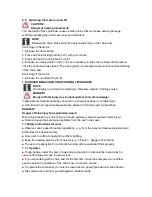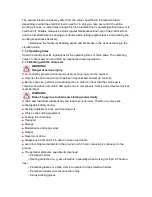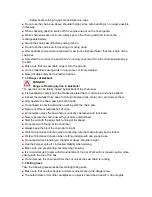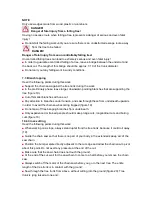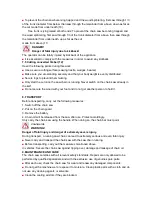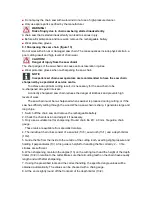
2.7 CAUSES AND OPERATOR PREVENTION OF KICKBACK
Kickback may occur when the nose or tip of the guide bar touches an object, or when the
wood closes in and pinches the saw chain in the cut.
Tip contact in some cases may cause a sudden reverse reaction, kicking the guide bar up
and back towards the operator.
Pinching the saw chain along the top of the guide bar may push the guide bar rapidly back
towards the operator.
Either of these reactions may cause you to lose control of the saw which could result in
serious personal injury. Do not rely exclusively upon the safety devices built into your saw.
As a chain saw user, you should take several steps to keep your cutting jobs free from
accident or injury.
Kickback is the result of tool misuse and/or incorrect operating procedures or conditions and
can be avoided by taking proper precautions as given below:
a
)
Maintain a firm grip, with thumbs and fingers encircling the chain saw handles, with both
hands on the saw and position your body and arm to allow you to resist kickback forces.
Kickback forces can be controlled by the operator, if proper precautions are taken. Do not let
go of the chain saw.
b
)
Do not overreach and do not cut above shoulder height. This helps prevent unintended tip
contact and enables better control of the chain saw in unexpected situations.
c
)
Only use replacement bars and chains specified by the manufacturer. Incorrect
replacement bars and chains may cause chain breakage and/or kickback.
d
)
Follow the manufacturer’s sharpening and maintenance instructions for the saw chain.
Decreasing the depth gauge height can lead to increased kickback.
2.8 SAFETY WARNINGS FOR BATTERY CHARGERS
1. Keep the battery charger away from rain or moisture. Penetration of water in the battery
charger increases the risk of an electric shock.
2. Do not charge other batteries. The battery charger is suitable only for charging lithium ion
batteries within the listed voltage range. Otherwise there is danger of fire and explosion.
3. Keep the battery charger clean. Contamination can lead to danger of an electric shock.
4. Before each use, check the battery charger, cable and plug. If damage is detected, do
not use the battery charger. Never open the battery charger yourself. Have repairs performed
only by a qualified technician and only using original spare parts. Damaged battery chargers,
cables and plugs increase the risk of an electric shock.
5. Do not operate the battery charger on easily inflammable surfaces (e. g., paper, textiles,
etc.) or surroundings. The heating of the battery charger during the charging process can pose
a fire hazard.
6. Children should be supervised to ensure that they do not play with the battery charger.


















